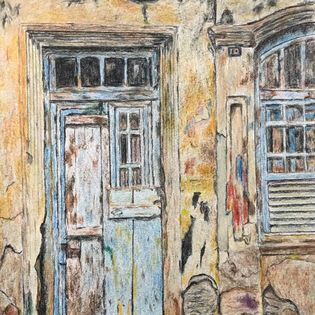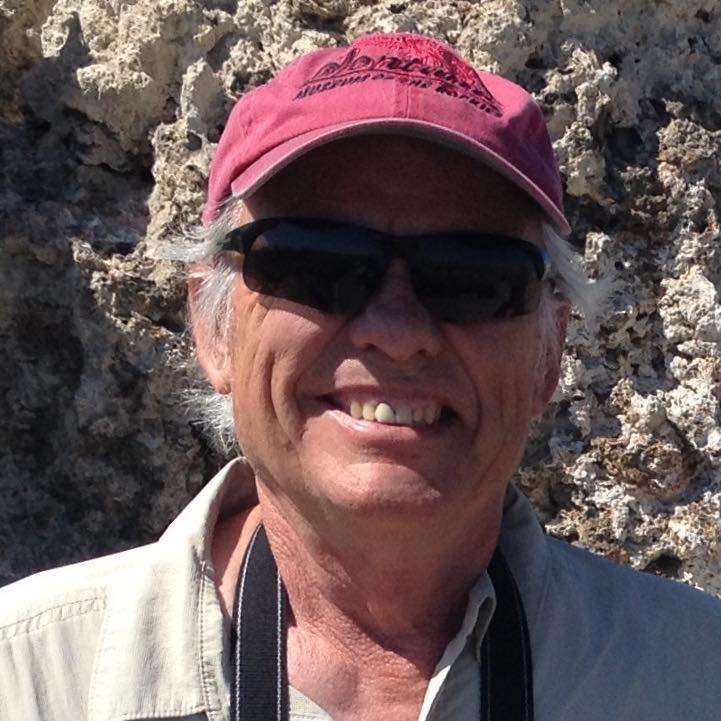Suddenly an Artist

Photo courtesy Valeria Strogoteanu
Meet artist Ken Grunewald
Ken is an artist, but he only discovered talent a few years ago. We are all constantly becoming, and Ken became an artist.


“Art flourishes where there is a sense of adventure.”
—Alfred North Whitehead
Tell us how and when and why you started drawing.
I started drawing during the pandemic while we were “locked up” in the house to pass time and try to amuse myself. I had never drawn before but started looking at artistic photos on the web and began trying to draw them. I went with color pencils because they required much less “equipment” and were much less messy than watercolors and oils. I only had the top of my desk in my office to use as an “art studio” so the less of everything the better. I stated with the web photos and then started drawing photographs I had taken on my trips to off the grid places around the world I had done in retirement. I continue to use these two sources for my drawings.
You draw lots of doors and windows. Why do you choose those subjects?
Windows and doors have always fascinated me. There is a certain mystery to them. What/who is in there, behind them? Also I love the texture and colors of old weathered, faded wood and corroded metal. I saw a lot of this in my travels to old cities around the world and during my time in historic preservation in the state of Arkansas. Also in an English composition course in college the professor told us to look at the door to the classroom and then write a 500 word composition on it. That made you really think about a door and all it encompasses. Who has walked through it over the years, what has it “seen” and heard over time, what is it made of and why, which way does it swing and why, what kind of hardware does it have, its texture and finish, etc.



What surprises you about drawing?
I am surprised at how much fun and absorbing it is once you get into a drawing. You can truly lose yourself in it and begin thinking of new ways to portray what is in your mind. Color pencils are great for this because they are mostly erasable. However, my erasers are like another pencil. You can create all sorts of effects with them. That was really surprising to me at first. They are far more than just for correcting mistakes - that is their minor function. Also, how much fun it is to blend colors together with pencils. All the colors in my drawings are blends of multiple colors - never just one. One last thing is how important it is to really see what you are drawing. Minor shapes, imperfections, subtle changes in textures and shades etc. Taken all together all these components add interest for the eye which before I started drawing I did not know.
Can you tell us a little about your process?
I draw in the major shapes and forms using a regular graphite pencil. Then I go back and begin putting in colors as I see them, blending and mixing. That’s the real fun part. I also put in surprises. Colors that don’t seem to belong, until they do. Greens and yellows with reds are my favorites. Once I have all the shapes and colors in I go back over all or parts of the drawing with a blending pencil. This does the final mixing and blending and gives them the mystery look I like. I don’t want the drawing to emulate a photograph. Rough and imperfect is what I often look for. Also I have been experimenting with minimalist style, which leaves completes shapes off and just hints at something being there.








“Art, in itself, is an attempt to bring order out of chaos.”
—Stephen Sondheim
A brief biography of the artist
I was very fortunate from my perspective to grow up in a nomadic life style. My father was career Air Force as was I. As a result I have lived in several states and four foreign countries. This gave me a broad world view and intense interest and appreciation of other lands and cultures at an early age. I acted on this interest after retirement by traveling off the tourist grid to 40 different countries on six continents.
I chose my travel destinations to meet and experience indigenous people and cultures. In several cases I lived with them for short periods—in yurts, tents, and other housing. I found this immersion in their families and lifestyle particularly spiritual and humbling. I was the only American on these trips, and often it was just me and my indigenous guide. I think if more people had exposure to highly different cultures we could live together more peacefully. These memories will last and effect my thoughts for the rest of my life.
Now more conventionally, I was born in San Angelo, Texas, and lived there three months before beginning the nomadic wanderings. Five states, three countries and 12 different schools later, including boarding schools in France and Germany, I enrolled at Texas A&M University. I signed up as a Forestry major since I wanted to major in something that would protect the environment. My ignorance was stunning. After our first field trip to a paper mill I withdrew and signed up for range management! Not wanting to help create an environment for cattle herds prior to slaughter and managing deer herds for hunting I withdrew from that as well. I then discovered something that extended the interest in people and cultures that I had cultivated all my life—Geography. Later majoring in geography at Penn State was one of the best decisions I have ever made.




I was in Air Force ROTC at Penn State with my lifelong goal of following my father’s footsteps and becoming a pilot, but failed the pilot eye test! Totally devastated, my choice was to drop out of the program and be drafted—Vietnam was raging—or stay in the program and do something else in the Air Force. I chose something else and became an intelligence officer. Great choice, since while going to intelligence school in Denver, CO I met the love of my life. I was sent to Vietnam directly out of Intelligence School, and we got married in Hawaii on my mid tour R&R. We are still
together 52 years later.
I had many interesting jobs in the Air Force, including being a crew commander for a Titan II ICBMs at Little Rock AFB, helping put the nation’s nuclear war plan together and putting information into the president’s “football” which contains the nuclear codes, and selecting targets Vietnam and N Korea when I was Seoul, Korea.
After retirement from the Air Force, I took a job with the Arkansas State Historic Preservation Program, eventually becoming the program director. Best job ever. Went from blowing things up to putting them back together again in two different career paths. After retirement from my second career, I spent a couple of years restoring a 1968 MGB Roadster, which was my wife’s car when we got married, and then going on adventure treks around the world. Our son and daughter-in-law are both pharmacists and live in Ohio with our three young grandchildren.


